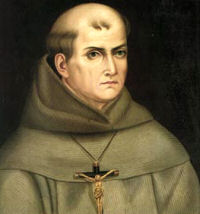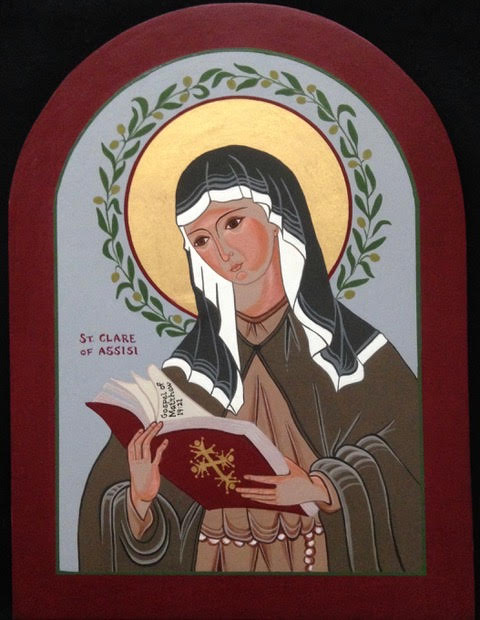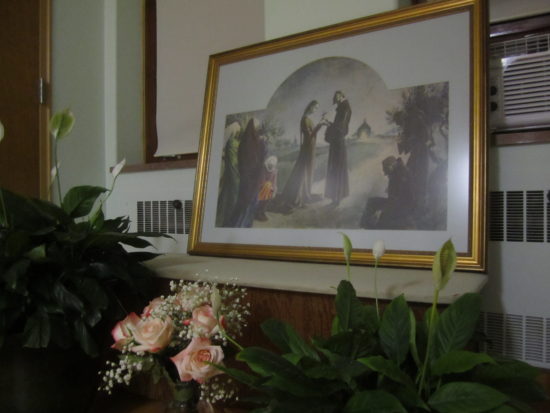Padre Serra, his love for and commitment to the native Americans
Padre Junipero Serra

Here is my servant in whom I am well pleased.”Isaiah: 42:1-4
Serra was 34 years old when he left a sought after professorship at the Llullian University in Palma, the capitol of Spanish Mallorca. He was a brilliant and extremely well read Franciscan friar. Junipero studied Aristotelian philosophy and held the chair of Scotistic Theology at the University named for Ramon Llull, the great theologian, missionary and friend among the Muslims in the late 13th century. In other words Junipero was on the progressive side of theological studies with a blossoming career before him. At that moment Serra headed out from Mallorca to the Missions of New Spain. Martyrdom was not uppermost in his mind. According to his student, life-long friend in the Missions, and Serra’s first biographer, Padre Francisco Palou, Serra felt the call to the missions as a path to spiritual renewal. He had a burning passion to baptize gentiles, children and their parents, bringing them through water and the Spirit into Christian life. As Jesus said to the Apostles: “Go out and make disciples of all nations, baptizing them in the name of the Father, Son and Holy Spirit.” Matt. 28:19
Miguel Josep, his baptismal name, was born into a poor family in the village of Petra on the Spanish island of Mallorca, a small island with great vistas, as a center for cartography and trade with the Muslims of Southern Spain and North Africa. He learned farming and animal husbandry from his father which would stand him well in his later years as president of the missions of Alta California. His early schooling was with the Franciscans and later at the Franciscan novitiate in Palma. At profession he chose the name Junipero, after the beloved companion of St. Francis of Assisi. We have four of his sermons to the Clares of Palma, recently translated from Catalan into English. His words are tender and loving as he speaks of a merciful God to tlhe Clares and others who came to hear him. Junipero was small of stature and in his preaching he was dynamic, articulate and sweet.
Junipero earned a doctorate in theology and held the chair of Scotistic theology at the Llullian University. On one occasion Junipero preached the sermon for the feast of Ramon Llull. One of the retired professors at the University was heard to say that “Serra’s presentation on Llull should be printed in gold.” Junipero had spent almost 20 years in studies, teaching and preaching in and around Palma. He was fully engaged in ministerial work when he and Padre Francisco Palou, decided to offer themselves to Mission work in New Spain. It was three months after Serra’s sermon on Llull.
New Spain 1750-1784“O Sing to our God a New Song.” Psalm 98:1-3 Junipero was assigned to ministry in Ciudad de Mexico and later in the Sierra Gorda area of Mexico. These were areas that had been Christianized long before Serra’s arrival. Serra waited 15 years before he got the assignment of his heart’s desire. He was missioned through Baja California to Alta California, a new area of missionary work for the Franciscan friars, and the beginning of a clash of cultures and religious practices between the local peoples and the friars. And this class wasn’t just between the Franciscans and the native Americans but also between the Spanish military and Padre Serra.
As Serra crossed into Alta California, his first meeting with the Kumeyaay or Diegueno people of California might be surprising to us. The men of the San Diego area whom Junipero encountered wore no clothing. (Remember, this is California not Minnesota. For Serra it was as if these people were from the Garden of Eden before there was any encounter with sin or the need for clothing.
“He went among the villagers teaching…Mark: 6
On the third occasion of traveling north from San Diego, Serra and his small group were passing through Chumash territory. They were bogged down in the muddy hills above Santa Barbara. Chumash warriors came to their aid and carried Serra through and out of the mud and set the party on their way. Padre Serra could never forget that experience. He referred to it many times.
Later it was Diegueno men who burned Mission San Diego and tortured and killed young Friar Jayme who was in charge of the mission. When the men who perpetrated this gruesome horror were captured Serra refused to have the men killed but insisted they live on to repent of what they had done. One of the leaders of the massacre became a close collaborator of Serra.
The Franciscan missionaries traveled with the Spanish and Mexican soldiers. Their objectives in Alta California were different. The soldiers were commissioned to acquire land for the Spanish crown and stop the Russian incursion from the north. Serra and the friars were concerned for the welfare and protection of the indigenous peoplesand therefore their assimilation for survival as Catholic Christians with skills of farming, ranching, wood working,tanning hides, etc, depending on the location of the Mission, as well as encouraging music, dance and the arts. The assimilated local peoples were called “ladinos.”
As long as Serra was alive the indigenous people had a fierce advocate for the people with the “commandants” and the soldiers. We see the greatness of the work of Serra and the Franciscans in contrast with what happened to the native peoples, as well as to the Mexicans, when California acquired Statehood in 1849.: the Mexicans lost their rancheros and the natives lost their lives. Long live the memory of Padre Junipero Serra.
Mexico seceded from Spain and claimed Alta California as well as New Mexico and Texas. In 1832 the anticlerical Mexican government began the secularization of the Missions and the friars were sent away. The plan was to hand the mission properties to the Native Americans but instead the new governing body sold off the Mission lands or gave them to friends. When California acquired Statehood in 1849 the Mexicans lost their rancheros and the natives lost their lives. Long live the memory of Padre Junipero Serra. May he intercede for us.
Feast of St. Clare
August 14, 2019

Clare of Assisi
This beautiful icon was written by
Bonnie Hardwick.
Homily for the Mass.
From the first reading, “I will allure her…and speak to her heart. “Hosea 2:16. Where will You allure her? Real estate agents love to say “Location, location, location…”Where was God leading Clare? God was leading her outside the walls of Assisi, down the hill to a tiny chapel, called the Little Portion, to meet with a motley crew of young men who would cut off her hair as a sign that she was joining their gang. That was her espousal to Our Lord Jesus Christ, and Francis was the best man. Clare joined the Friars.
It was a challenge to find the right spot for Clare, and for the women who would be with her. Bishop Guido, the ordinary of the diocese of Assisi, had a spot. He offered a small chapel that was under his jurisdiction. It was outside the walls of Assisi and down the hill on the well-traveled road that led up into the town of Assisi. There to this day, is the chapel of San Damiano even if the Clares are no longer there. San Damiano was on the other side of the hill from the Little Portion of the friars. Between the two Franciscan Chapels was the Leprosarium. “Location, location, location…”
The second reading for the feast is taken from Paul’s 2nd letter to the Corinthians, “God let light shine in our hearts…even when we are affected in every way…” These exquisite readings for the feast of Clare were chosen by the friars after Vatican II for the feast of Clare. In this second reading we hear that the light is always there shining in the hearts of Clare and her Sisters that they might make known the glory of God shining on the face of Jesus. And they would do that in the presence of great challenges. There is no doubt that the light was shining on the face of Clare and her Sisters at San Damiano when they stared down the Saracen invaders. What I would like to bring to your attention at this point, is that it was a shared light, shared with Francis and the brothers who the Clares always had with them “through the kindness of the Order of Lesser Brothers.” Chap 12 in the Form of Life and “who were always faithful to the Sisters” the words of Clare. Francis and his closest companions never abandoned Clare and the Sisters at San Damiano. Clare and her Sisters were never distant from Leo, Juniper, Angelo, her cousin Rufino, Elias, and others. When Clare was dying Brother Rainaldo got Clare’s ire up when he told her to be patient in her sickness. She, in a “very unrestrained voice” (shouted) responded, “that since she came to know Jesus through Brother Francis nothing has been too hard.” At Clare’s death bed Juniper was there with his hijinks delighting Clare. Angelo, her cousin, while mourning himself was consoling the others, and Leo kissed her bed. The sisters and brothers were all crying. So much for strict enclosure.
And poor old Celano writes “Who could narrate the rest without crying.” But, of course, he continues. Listen to this line, “Faces were swollen with tears and the fury of the mourning heart supplied ever new waters.”
At that moment Clare turned away and said quietly to herself, “Go without anxiety for you have a good guide for your journey, for the one who created you has loved you and made you holy.”
From today’s Gospel, John 15:4-10, Jesus says “My Father has been glorified in your bearing much fruit.”
After Clare’s death her body was carried up the hill into the city of Assisi to the Church of St. Georgio where Francis’s body had been laid at his death before being transported to the grand basilica named for him. Clare’s remains were buried deep under the altar of the Church of San Georgio which was incorporated into the grand basilica of St. Clare. It was more than 7 hundred years before the bones of St. Clare were exhumed and placed at a barred window in a side room of the basilica.
When I visited Assisi in 1970 on the way to our new Clarian foundation in Zambia I visited the window where Clare’s remains were on view. I saw some bones with a black gauze pulled over the bones. Those were the remains of her earthly life. But where was Clare? “Location, Location, location.”
